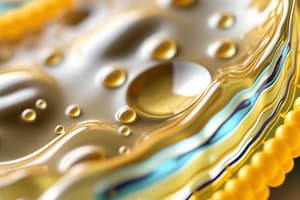Podcast
Questions and Answers
Which of the following describes a mode of lipid mobility in a lipid bilayer?
Which of the following describes a mode of lipid mobility in a lipid bilayer?
- Static bonding
- Fast axial rotation (correct)
- Slow lateral diffusion
- Flip-flop exchange (correct)
Membranes consist of 70% lipid, 20% protein, and 10% carbohydrate.
Membranes consist of 70% lipid, 20% protein, and 10% carbohydrate.
False (B)
What is the primary function of cholesterol in cell membranes?
What is the primary function of cholesterol in cell membranes?
- Stabilize the membrane (correct)
- Form lipid bilayers
- Act as an energy transducer
- Increase membrane fluidity
What are the three major classes of membrane lipids?
What are the three major classes of membrane lipids?
What is a characteristic of membrane proteins?
What is a characteristic of membrane proteins?
Membrane lipids are described as __________ molecules.
Membrane lipids are described as __________ molecules.
What prevents proteins from flip-flopping in the lipid bilayer?
What prevents proteins from flip-flopping in the lipid bilayer?
Name a type of non-classical phospholipid found in cell membranes.
Name a type of non-classical phospholipid found in cell membranes.
Flashcards are hidden until you start studying
Study Notes
Dynamics in Lipid Bilayers
- Lipid bilayers exhibit fluid dynamics with four primary modes of lipid mobility: fast lateral diffusion, flip-flop, intra-chain motion, and fast axial rotation.
- Fast lateral diffusion allows lipids to move rapidly within the bilayer plane.
- Flip-flop refers to lipid molecules moving from one side of the bilayer to the other on a one-for-one basis.
- Intra-chain motion involves the formation of kinks in fatty acyl chains, enhancing structural variability.
- Fast axial rotation refers to the quick spinning of lipid molecules around their axes.
General Functions of Biological Membranes
- Serve as a selective permeability barrier, controlling the entry and exit of substances.
- Maintain control over the chemical environment of cells and organelles.
- Facilitate cellular communication and information exchange with the environment.
- Enable recognition functions through signaling molecules and adhesion proteins.
- Generate signals in response to stimuli, essential for physiological responses.
Membrane Composition
- Composed of approximately 40% lipids, 60% proteins, and 1-10% carbohydrates, with around 20% water contributing to hydration.
Membrane Lipids
- Form the dual-layered structure that constitutes cell membranes, composed of amphipathic molecules.
- The three major classes of membrane lipids are phospholipids, glycolipids, and cholesterol.
- Phospholipid structures include hydrophilic heads (glycerol and phosphate) and hydrophobic tails (fatty acids).
Importance of Unsaturated Fatty Acids and Cholesterol
- Unsaturated fatty acids disrupt orderly packing, enhancing membrane fluidity.
- Cholesterol plays a critical role in membrane stability by hydrogen bonding with fatty acid chains, altering fluidity dynamics.
Membrane Proteins
- Integral to membrane function, serving as enzymes, transporters, pumps, ion channels, receptors, and energy transducers.
- Protein content ranges from 18% in myelin to 75% in mitochondria, with an approximate average of 60% dry weight in membranes.
Mobility of Proteins in Bilayers
- Proteins exhibit three types of motion: conformational change, rotational, and lateral movement; flip-flop movement is restricted due to protein structure.
- Mobility restrictions are influenced by lipid interactions, membrane protein associations, and connections with peripheral proteins like the cytoskeleton.
Cholesterol in Cell Membrane
- Constitutes about 45% of total membrane lipids, with variations in distribution based on tissue function.
- Stabilizes the membrane by reducing the endothermic phase transition and impacting phospholipid chain movement, which both increases and decreases membrane fluidity.
Lipid Bilayer Structure
- Formed spontaneously in water, driven by van der Waals forces between hydrophobic tails.
- Stabilized by non-covalent interactions including hydrogen bonding and electrostatic forces.
- Preferred structure for phospholipids and glycolipids, with low permeability to ions and polar molecules.
Phospholipids
- Predominant lipid in membranes; phosphatidylcholine is a common example.
- Possess a variety of polar head groups (e.g., choline, amines, sugars).
- Fatty acid chains are diverse, with C16 and C18 being most common; unsaturated chains decrease packing due to the kinks introduced by double bonds.
Unique Lipid Types
- Plasmalogens: Non-classical phospholipids prevalent in nervous, immune, and cardiovascular systems.
- Sphingomyelin: A type of sphingolipid found in cell membranes, crucial for myelin in nerve axons.
- Glycolipids: Molecules combining carbohydrates with fatty acid tails; include cerebrosides (sugar head group monomers) and gangliosides (more complex sugars).
Studying That Suits You
Use AI to generate personalized quizzes and flashcards to suit your learning preferences.



